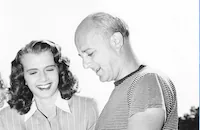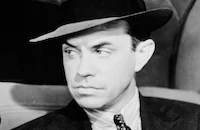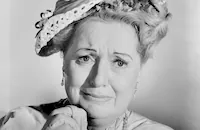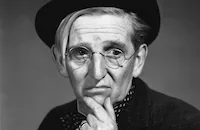Crashing Hollywood

Brief Synopsis
Cast & Crew
Lew Landers
Lee Tracy
Joan Woodbury
Paul Guilfoyle
Lee Patrick
Richard Lane
Film Details
Technical Specs

Synopsis
On a California-bound train, Goldie Tibbitts and her husband Herman, an ex-convict, ambush aspiring screenwriter Michael Winston, whose script-filled briefcase Goldie mistakenly believes contains $50,000 in stolen bonds. As aspiring actress Barbara Lang rushes for the train authorities to save Michael, Michael and the Tibbittses calmly agree to collaborate on a screen story that will feature Herman's former crime boss and betrayer, The Hawk. The next morning, Barbara snubs Michael as they deboard in Los Angeles, angry at his apparent deception. Unable to convince Barbara of his innocence, Michael pursues his screenwriting, crashing the office of eccentric movie mogul Hugo Wells with the Tibbittses in tow. Without hearing a word, Wells declares the trio geniuses and hires them to write their story at $2,000 per week. The subsequent popularity of the movie, which is a faithful recreation of Herman's last heist at the Austin Bank starring The Hawk look-alike, Thomas Darcy, attracts the attention of Barbara, who finally forgives and reunites with Michael. It also comes to the attention of the real Hawk, whose gangster's pride is offended by Herman's unflattering, vengeful portrait of him. At the same time, Alexander Peyton, the Austin Bank president, and private detective Decker become convinced that Michael was involved with the robbery and track him to his Hollywood home. After Goldie recognizes The Hawk and his "trigger man," Al, leaving Michael's house, she rushes to the studio to alert Herman and Michael, just as Barbara encounters Decker and Peyton. Although Barbara doubts Michael's background again, she nevertheless tries to warn him about Decker and Peyton, who are already questioning him as police surround the studio building. In the midst of the ensuing chaos, The Hawk, who is impersonating Darcy impersonating The Hawk, shoots at Herman on the set of the new "Hawk" movie, but is pursued and finally caught by Michael, who proves his innocence once and for all.

Director

Lew Landers
Cast

Lee Tracy

Joan Woodbury

Paul Guilfoyle

Lee Patrick

Richard Lane

Bradley Page

Tom Kennedy

George Irving
Frank M. Thomas

Jack Carson
Alec Craig

James Conlin
Crew
Gladys Atwater
Samuel J. Briskin
Denzil A. Cutler
Feild M. Gray
Harry Marker
Nicholas Musuraca
Van Nest Polglase
Frank Redman
Cliff Reid
Renié
Darrell Silvera
Vernon L. Walker
Paul Yawitz

Videos
Movie Clip


Film Details
Technical Specs

Articles
Crashing Hollywood
This Hollywood satire was based on a 1922 play by Paul Dickey and Mann Page called Lights Out, which was adapted into a 1923 film of the same name directed by Alfred Santell. For this remake, RKO assigned Lew Landers, one of Hollywood's most prolific directors. In fact, Crashing Hollywood was the first of eight movies he directed for release in 1938 alone. It's also smartly cast, with enjoyable character actors like Richard Lane, George Irving and Lee Patrick joining Tracy, Guilfoyle and Joan Woodbury to make for a snappy time. Lee Tracy's first film, incidentally, had been one of the very first talkies with a Hollywood subject matter: Big Time (1929).
Movies about Hollywood are as old as movies themselves, and audiences always seem to be fascinated by them, whether they are A-level classics like The Bad and the Beautiful (1952) or cheap quickies like Crashing Hollywood. Oftentimes the less glittery films are the more revealing. As film scholar William K. Everson has written, "Crashing Hollywood contains a lot more honesty about day-to-day Hollywood than many of the much more ambitious pictures that were always striving for effect, carefully dropping a name here or a pseudo-documentary 'fact' there. The B's had no time for that -- they just got on with their story-telling, using undisguised studio sets and offices for their background. Crashing Hollywood is a particularly slick little picture, combining an amusing story-premise with good action and fast-paced dialogue, the Lee Tracy personality keeping everything hanging together rather nicely."
By Jeremy Arnold

Crashing Hollywood
Quotes
Trivia
The original play opened in New York City, New York, USA on 14 August 1922, but closed after only 12 performances.
Notes
The working title of this film was Lights Out. Motion Picture Herald's "In the Cutting Room," lists Leona Roberts, Maxine Jennings and Cecil Kellaway as cast members, while a Hollywood Reporter news item lists Grace Cunard, Richard Parker and Edythe Elliott. Their participation in the final film has not been confirmed. In 1923, Al Santell directed Ruth Stonehouse and Walter McGrail in Lights Out, an R-C Pictures version of Paul Dickey and Mann Page's stage play (see AFI Catalog of Feature Films, 1921-30; F2.3088).














